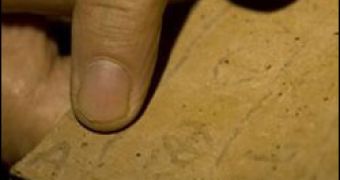Following the recent association of an ancient copper mine with King Solomon, another such example comes in the form of the discovery of a pottery shard containing what appears to be possibly the oldest Hebrew inscription ever found. The Israeli archaeologist who made the discovery associates the three-millennia-old shard to written texts that could have been the source for the Biblical tales of the empire of King David, King Solomon's father.
The item was unearthed this July from a hill south of Jerusalem by a teenage volunteer. It displays five lines of faint proto-Canaanite scribbling (a forerunner for the Hebrew writing) which Yossi Garfinkel, the Israeli archaeologist in charge of the operations at Hirbet Qeiyafa (the place of the discovery), believes to be the proof of the fact that the Israelites of that time were literate and perfectly able to record events in a written fashion hundreds of years before the Biblical events.
But other scientists warn against jumping to conclusions, since the proto-Canaanite characters didn't generate only the Israelite alphabet, so it would not be safe to state that the text is necessarily Hebrew. In response, Garfinkel claims to have identified a three-letter word which would be translated “to do”, only used in the Hebrew language. So far, the translating team has only managed to tentatively identify a few other words, such as “judge,” “slave” and &ldquoking.”. The C-14 dating suggests the pottery which the shard is part of was created sometime between 1,000 and 975 BC.
Together with the fact that the Bible depicts the place of the fragment's discovery (near the Elah Valley) as the region where the slingshot battle between David and the Philistine giant Goliath was fought, this could add credibility to Garfinkel's version. On the other hand, many scholars claim there's no actual proof of David's empire ever existing, or at least that the Bible has largely exaggerated its importance. Anyway, Biblical disputes aside, the fragment will still be held in high regard as proof to how writing has evolved over millennia, since the next most ancient is about 100-200 years younger, while the Dead Sea scrolls were created only 850 years later.

 14 DAY TRIAL //
14 DAY TRIAL //